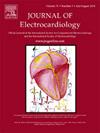HCM患者心电图与MCE的相关性及其临床意义
IF 1.2
4区 医学
Q3 CARDIAC & CARDIOVASCULAR SYSTEMS
引用次数: 0
摘要
背景:心电图st段下降(STD)是检测心肌缺血最常用的检查方法,心肌超声造影(MCE)被认为是评估心肌灌注的可靠技术。然而,两项检查与肥厚性心肌病(HCM)患者的潜在临床意义之间的关系尚未得到充分说明。目的探讨HCM患者心电图与MCE的相关性,并阐明其潜在的临床意义。方法32例HCM确诊患者和28例健康人作为对照。观察两组患者ST段下移幅度(STD),记录两组患者的MCE参数:峰值强度(PI)、曲线下面积(AUC)、上升斜率(RS)、到达峰值时间(TTP),并计算MCE参数与STD程度的相关性。此外,HCM患者根据性病严重程度分为3个亚组:ST1组(0 <;STD≤0.1 mV);ST2组(0.1 mV <;STD≤0.2 mV);ST3组(0.2 mV <;STD≤0.3 mV),四组数据比较。结果secg显示HCM组患者均存在性病(t = 8.294, P <;0.001)。MCE显示,与对照组相比,HCM组PI、RS和AUC值显著降低(P <;0.001)。相关分析结果显示,PI值与性病程度无线性相关(r =−0.348,P = 0.051)。值得注意的是,ST1与ST3、ST2与ST3的PI值差异有统计学意义(P = 0.01)。结论STD > 0.2 mV强烈提示HCM患者心肌灌注损害,可作为HCM患者分层和高危人群识别的可靠指标。本文章由计算机程序翻译,如有差异,请以英文原文为准。
Correlation between ECG and MCE findings in HCM patients and clinical implications
Background
ST segment depression (STD) on electrocardiogram (ECG) is the most frequently used examination to detect myocardial ischemia and myocardial contrast echocardiography (MCE) is considered as a reliable technique to assess myocardial purfusion. However, association between two examinations and the underlying clinical implication in hypertrophic cardiomyopathy (HCM) patients is not fully illustrated.
Objective
To investigate the correlation between ECG and MCE findings in HCM patients and elucidating the underlying clinical implications.
Methods
Thirty-two patients diagnosed with HCM comprising the HCM cohort and 28 healthy individuals were enrolled as controls. The amplitude of ST segment depression (STD) was assessed, and the following MCE parameters: peak intensity (PI), area under the curve (AUC), rising slope (RS) and time to peak (TTP) were recorded and compared between the two groups, and correlation between MCE parameters and the extent of STD was calculated. Furthermore, HCM patients were categorized into three subgroups according to the severity of STD: ST1 group (0 < STD ≤ 0.1 mV); ST2 group (0.1 mV < STD ≤ 0.2 mV); ST3 group (0.2 mV < STD ≤ 0.3 mV), and data was compared among the four groups.
Results
ECG showed that all patients in the HCM group present STD (t = 8.294, P < 0.001). MCE showed that the values of PI, RS, and AUC were significantly reduced in the HCM group as compared to the control group (P < 0.001). Results of correlation analysis show no linear correlation between the PI values and the extent of STD (r = −0.348, P = 0.051). Of note, a significant difference in PI values between ST1 and ST3 (P = 0.01), ST2 and ST3 (P = 0.023) was observed.
Conclusion
Our findings reveal that STD greater than 0.2 mV strongly indicates myocardial perfusion impairment in HCM patients, and can serve as a reliable index for stratifying patients and identifying those at high risk.
求助全文
通过发布文献求助,成功后即可免费获取论文全文。
去求助
来源期刊

Journal of electrocardiology
医学-心血管系统
CiteScore
2.70
自引率
7.70%
发文量
152
审稿时长
38 days
期刊介绍:
The Journal of Electrocardiology is devoted exclusively to clinical and experimental studies of the electrical activities of the heart. It seeks to contribute significantly to the accuracy of diagnosis and prognosis and the effective treatment, prevention, or delay of heart disease. Editorial contents include electrocardiography, vectorcardiography, arrhythmias, membrane action potential, cardiac pacing, monitoring defibrillation, instrumentation, drug effects, and computer applications.
 求助内容:
求助内容: 应助结果提醒方式:
应助结果提醒方式:


